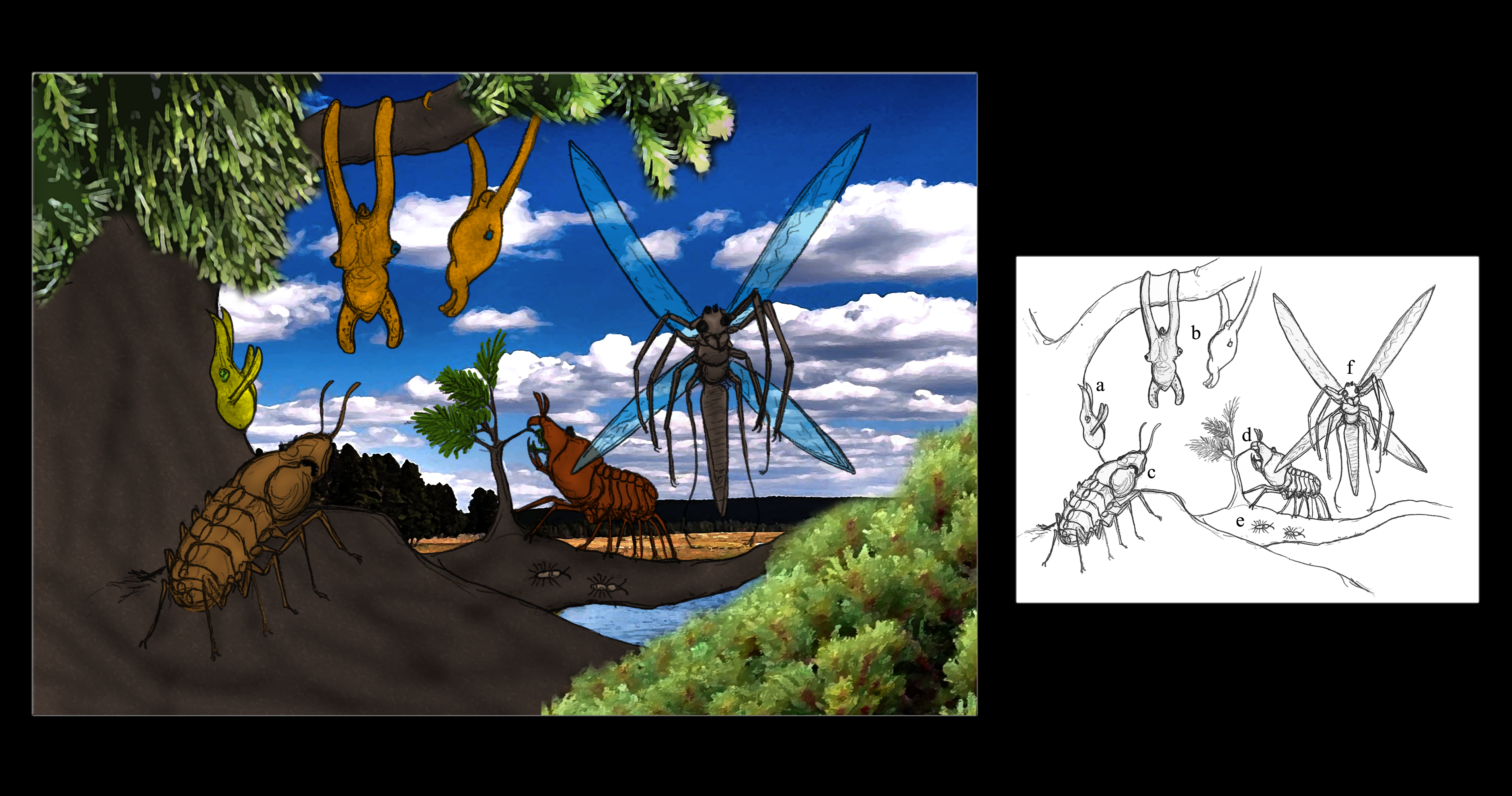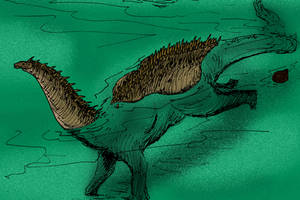Deviation Actions
Badge Awards
Description
They had several advantages at first, as the warm weather that allowed the emergence of huge forests, the lesser gravity which allowed them to support their soft bodies and long after the lack of competition from vertebrates.
The conquerors arthropods of the land on Mars, are completely different to the conquerors of our world, there are no recognizable groups of arthropods such as insects, millipedes and spiders, although onychophorans have evolved, but they are another story. Into the void, some species that never had a chance achieved to evolve, many of them descendants of the trilobites, pycnogonids and some species of crustaceans and unidentifiable arthropods. However, the victorious proved trilobites and pycnogonids.
On the side of molluscs, a completely new and different thing is observed. Although gastropods are present, and even managed to develop terrestrial forms similar to snails, were not alone. because the descendants of the Nectocaris, the probable Cambrian cephalopods, were adapted to terrestrial environment, probably taking advantage of the minor gravity.
The first groups of terrestrial invertebrates emerged in the late 'marinerian period "and early" period Vikingnian "(420-370 mya, but the date varies). During part of Vikingnian and all Olimpian most of these invertebrates had grown to enormous sizes, due to the huge amounts of oxygen in the air, but they disappeared soon after the appearance of onychophorans and Thyreocephala (land dinocaridida), and the reduction of oxygen in the atmosphere. For the Fugarian period (250-224 mya) the main dominant arthropods are the descendants of the trilobites, seconded by pycnogonids and the nectocarid molluscs descendants.
Cephalopod
The Exonectidae are a subclass of Cephalopoda derived from nectocaridae, which are fully adapted to life on land. They do not have some kind of outer covering like shell, and mouth, like the other descendants of Nectocaris, is not made by a peak, it is formed by a radula, with several mouthparts around the mouth hole that function as teeth.
The most primitive species have yet to return to the water to keep moist and reproduce, while the more advanced have an efficient respiratory system able to absorb oxygen from the air. They have a kind of "pseudo-skeletal structures" made up of cartilage that allow them to support your body.
Families
Pterygopodae
(Feet fins)
These are one of the oldest existing land exonectids are creatures of robust appearance, stubby tentacles, with long fleshy appendages used to mobilize.
Scandetheutomorphidae
(Climber similar to a squid )
They are derived from tree Pterygopodae forms, which are characterized by their long, flexible tentacles that allow them to hang from the branches of trees, the appendages derivatives from the fins only serve to sustain the animal when in repose.
Trilobites
Cydonops
(The face of Cydonia)
It's name comes from the Cydonia region, where these have evolved
Pycnogonids
Strictostomatids
(Narrow mouth)
The Strictostomatids are a group of Chelicerata own alternate on Mars, descendants of the pantopoda, or known as "Sea spiders" in earth.
They are quite different from their ancestors by their morphological characteristics: reduction of segmented thorax, abdomen elongation; The chelicerae, have evolved into a specialized mouth to grind foods, which are collected by the proboscis. The cephalon have a separate chest, in which are located four eyes, pedipalps and the mouth that are described above.
A subclass of these, known as Aeropulmonaptera, has developed the ability to fly using membranous wings, which is unable to determine its origin.
------------------------------------------------------------------------------------
En medio del follaje de los enormes "arboles multi-tallos" se encuentran las pequeñas comunidades, pero con una enorme diversidad, de invertebrados terrestres. Los Pterygopoda (a) ha evolucionado de manera convergente a los gasterópodos terrestres, y los Scandetheutomorpha (b) son criaturas agiles que utilizan sus fuertes tentáculos para columpiarse entre las ramas; los Cidonops (c, d, e), son los mas diversos artrópodos de Marte, ocupan la mayor parte de los nichos de insectos y los Strictostomata (f) son los únicos artrópodos no dinocaridida que son capaces de volar.
Como en la Tierra, en Marte, evolucionaron una gran cantidad, de invertebrados terrestres, que se expandieron y conquistaron cada tipo de ambiente.
Tuvieron varias ventajas al principio, como el clima cálido que permitió el surgimiento de enormes selvas, la menor gravedad que les permitió soportar sus cuerpos blandos y mucho tiempo después como la falta de competencia por parte de los vertebrados.
Los artrópodos conquistadores de la tierra, en Marte, son completamente diferentes a los conquistadores de nuestro mundo, no existen los grupos reconocibles de artrópodos como insectos, miriápodos o arácnidos, aunque si han evolucionado los onicóforos, pero, ellos son otra historia. En el vacio, algunas especies que nunca tuvieron la oportunidad logran evolucionar, varios de ellos descendientes de los trilobites, picnogónidos y algunas especies de crustáceos y artrópodos no identificables. Sin embargo, los victoriosos resultaron ser los trilobites y los picnogónidos. Por el lado de los moluscos, se observa una cosa completamente nueva y diferente, a pesar de que los gasterópodos son presentes, e inclusive lograron desarrollar formas terrestres muy similares a los caracoles, no fueron los únicos, ya que los descendientes de los nectocaris, los probables cefalópodos cámbricos, se adaptaron al ambiente terrestre, probablemente tomando la ventaja de la menor gravedad.
Los primeros grupos de invertebrados terrestres surgieron a finales del periodo marinerian y principios del periodo Vikingnian (420-370 mya, pero la fecha varia). Durante parte del periodo Vikingnian y todo el olimpiano la mayoría de estos invertebrados habían crecido hasta alcanzar enormes tamaños, debido a las enormes cantidades de oxigeno en el aire, aunque estos desaparecieron poco tiempo después con la aparición de los onicóforos y de los Thyreocephala (Dinocarididos terrestres), y por la reducción de oxigeno en la atmosfera. Para el periodo fugarian (250-224 mya) los principales artrópodos dominantes son los descendientes de los trilobites, secundados por los picnogónidos y los moluscos.
Cefalópoda
Reino: Animalia
Filo: Mollusca
Clase: Cephalopoda
Subclase: Exonectidae
Los Exonectidae son una subclase de Cephalopoda derivada de los nectocaridae, los cuales están completamente adaptados a la vida terrestre. No poseen algún tipo de cubierta externa como concha, y la boca, al igual que los otros descendientes de nectocaris, no esta conformada por un pico, sino que esta conformada por una rádula, junto a varias piezas bucales alrededor del orificio bucal que funcionan como dientes.
Las especies mas primitivas aun tienen que volver al agua para mantenerse húmedos y para reproducirse, mientras que las mas avanzadas poseen un sistema respiratorio eficiente capaz de absorber el oxigeno del aire. Ellos poseen un tipo de “pseudo-estructuras esqueléticas” conformadas por cartílagos que les permiten soportar su cuerpo.
Familias
Pterygopodae
(Pies aletas)
Estos son uno de los más antiguos exonectids terrestres existentes, son criaturas de aspecto robusto, de tentáculos rechonchos, con largos apéndices carnosos que utilizan para movilizarse.
Scandetheutomorphidae
(Trepador similar a un calamar)
Se derivan de las formas arbóreas de Pterygopodae, los cuales se caracterizan por sus largos y flexibles tentáculos que les permiten aferrarse entre las ramas de los arboles, los apéndices derivados de las aletas de natación sirven solo como para sostener al animal cuando esta en reposo.
Trilobites
Cydonops
(La cara de cydonia)
Reino: Animalia
Filo: Arthropoda
Subfilo: Bilobita
Clase: Cydonopsa
Los Cydonops son una clase de artrópodos descendientes de los trilobites, pertenecientes a un nuevo subfilo derivados de los Trilobitomorpha. Su morfología difiere de sus ancestros, ya que han perdido el cuerpo aplanado, ovalado y liso común en estos. Su cuerpo se divide en dos partes, el cefalón, en donde se ubican los organos sensoriales, parte del sistema digestivo, y una parte del sistema nervioso; El tórax y el Pigidio ahora conforman una sola parte, la cual el pigidio se encuentra bajo el tórax. El número de segmentos se han reducido, al igual que el número de extremidades. Estos perdiendo sus lóbulos pleurales que protegían sus apéndices. Su boca en forma de pico es derivada de su única pieza bucal que se ubicaba en medio del cefalón, y que al evolucionar, se trasladó hasta la parte delantera, a su vez, son secundadas por 2 pares de apéndices especializados para actuar como piezas bucales extras.
Su nombre proviene de la región de cydonia, en donde estos evolucionaron
Picnogónidos
Strictostomatids
(Boca estrecha)
Reino: Animalia
Filo: Arthropoda
Subfilo: Chelicerata
Clase: Strictostomata
Los Strictostomatids son un grupo alterno de Chelicerata propio de Marte, descendientes de los pantópodos, o conocidas como arañas de mar en la era humana.
Difieren bastante de sus ancestros por sus características morfológicas: la reducción del tórax segmentado, el alargamiento del abdomen, y Los quelíceros, han evolucionado hasta convertirse en una boca especializada para triturar alimentos, los cuales son recogidos por la probóscide. Poseen un cefalón separado del tórax, en el cual se ubican 4 ojos, los pedipalpos y la boca descrita anteriormente.
Una subclase de estos, conocida como Aeropulmonaptera, ha desarrollado la capacidad de vuelo utilizando alas membranosas, las cuales, no se puede determinar su origen.
































